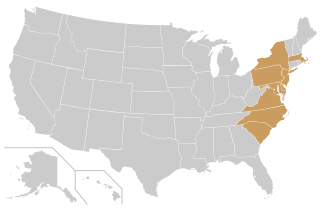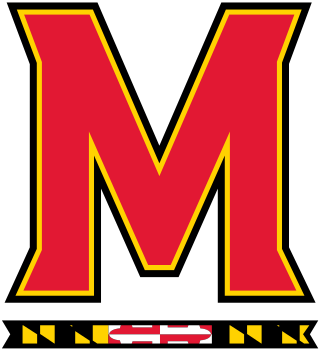
The Atlantic Coast Conference (ACC) is a collegiate athletic conference located in the United States. Headquartered in Charlotte, North Carolina, the ACC's fifteen member universities compete in the National Collegiate Athletic Association (NCAA)'s Division I. ACC football teams compete in the NCAA Division I Football Bowl Subdivision. The ACC sponsors competition in twenty-seven sports with many of its member institutions held in high regard nationally. Current members of the conference are: Boston College, Clemson, Duke, Florida State, Georgia Tech, Louisville, Miami, North Carolina, NC State, Notre Dame, Pittsburgh, Syracuse, Virginia, Virginia Tech, and Wake Forest.

The Big East Conference was a collegiate athletics conference that consisted of as many as 16 universities in the eastern half of the United States from 1979 to 2013. The conference's members participated in 24 NCAA sports. The conference had a history of success at the national level in basketball throughout its history, while its shorter football program, created by inviting one college and four other "associate members" into the conference, resulted in two national championships.

The Big Ten Conference is the oldest Division I collegiate athletic conference in the United States. Founded as the Intercollegiate Conference of Faculty Representatives in 1896, it predates the founding of its regulating organization, the NCAA. It is based in the Chicago area in Rosemont, Illinois. For many decades the conference consisted of 10 prominent universities, which accounts for its name. As of 2014, it consists of 14 member institutions and 2 affiliate institutions, with 4 new member institutions scheduled to join in 2024. The conference competes in the NCAA Division I and its football teams compete in the Football Bowl Subdivision (FBS), formerly known as Division I-A, the highest level of NCAA competition in that sport.

The Atlantic 10 Conference (A-10) is a collegiate athletic conference whose schools compete in the National Collegiate Athletic Association's (NCAA) Division I. The A-10's member schools are located mostly on the East Coast and Midwest of the United States: Illinois, Massachusetts, Missouri, New York, North Carolina, Ohio, Pennsylvania, Rhode Island, Virginia, and Washington, D.C.

The Southern Conference (SoCon) is a collegiate athletic conference affiliated with the National Collegiate Athletic Association (NCAA) Division I. Southern Conference football teams compete in the Football Championship Subdivision. Member institutions are located in the states of Alabama, Georgia, North Carolina, South Carolina, Tennessee, and Virginia.

The Coastal Athletic Association (CAA), formerly the Colonial Athletic Association, is a collegiate athletic conference affiliated with the NCAA's Division I whose full members are located in East Coast states, from Massachusetts to South Carolina. Most of its members are public universities, and the conference is headquartered in Richmond. The CAA was historically a Southern conference until the addition of four schools in the Northeastern United States after the turn of the 21st century, which added geographic balance to the conference.

Rowing is the oldest intercollegiate sport in the United States. The first intercollegiate race was a contest between Yale and Harvard in 1852. In the 2018–19 school year, there were 2,340 male and 7,294 female collegiate rowers in Divisions I, II and III, according to the NCAA. The sport has grown since the first NCAA statistics were compiled for the 1981–82 school year, which reflected 2,053 male and 1,187 female collegiate rowers in the three divisions. Some concern has been raised that some recent female numbers are inflated by non-competing novices.

The Power Five conferences are the five most prominent athletic conferences in college football in the United States. They are part of the Football Bowl Subdivision (FBS) of NCAA Division I, the highest level of collegiate football in the nation, and are considered the most elite conferences within that tier. The Power Five conferences have provided nearly all of the participants in the College Football Playoff since its inception, and generally have larger revenue, budgets, and television viewership than other college athletic programs.

The Maryland Terrapins, commonly referred to as the Terps, consist of 19 men's and women's varsity intercollegiate athletic teams that represent the University of Maryland, College Park in National Collegiate Athletic Association (NCAA) Division I competition. Maryland was a founding member of the Southern Conference in 1921, a founding member of the Atlantic Coast Conference in 1952, and a member of the Big Ten Conference since 2014.

The East Coast Conference was an college athletic conference at the Division I of the National Collegiate Athletic Association (NCAA). It was founded as the university division of the Middle Atlantic Conferences (MAC) in 1958. The MAC consisted of over 30 teams at that time, making it impossible to organize full league schedules in sports like football, basketball, and baseball. In 1958, the larger schools created their own mini conference, consisting of 11 members.

The Clemson Tigers are the athletic teams that represent Clemson University, located in Clemson, South Carolina. They compete as a member of the National Collegiate Athletic Association (NCAA) Division I level. Clemson competes for and has won multiple NCAA Division I national championships in football, men's soccer, and men's golf. The Clemson Tigers field twenty-one athletic teams, nine men's and twelve women's, across thirteen sports.

The ACC Championship Game is an annual American college football game held in early December by the Atlantic Coast Conference (ACC) each year to determine its football champion. From its inception in 2005 to 2022, the game pit the champion of the Coastal Division against the champion of the Atlantic Division in a game that follows the conclusion of the regular season. The current champions are the Florida State Seminoles.
The ACC men's basketball tournament is the conference championship tournament in men's basketball for the Atlantic Coast Conference (ACC). It has been held every year since the ACC's first basketball season concluded in 1954. The ACC tournament is a single-elimination tournament and seeding is based on regular season records. The winner, declared conference champion, receives the conference's automatic bid to the NCAA men's tournament.

The 2005 NCAA conference realignment was initiated by the movement of three Big East Conference teams to the Atlantic Coast Conference, which set events into motion that created a realignment in college football, as 23 teams changed conferences and Army became an independent.

The 2010–2014 NCAA conference realignment was a set of extensive changes in conference membership at all three levels of NCAA competition—Division I, Division II, and Division III—beginning in the 2010–11 academic year.
The Atlantic Coast Rugby League was an annual college rugby competition played every spring among eight universities—seven from the Atlantic Coast Conference, plus Navy. The league was disestablished in 2016.

The 2010–14 Big Ten Conference realignment refers to the Big Ten Conference dealing with several proposed and actual conference expansion and reduction plans among various NCAA conferences and institutions from 2010 to 2014. U.S. sports media credited expansion plans by the Big Ten as being the trigger for a massive wave of conference realignment during this period. While no Big Ten members announced plans to join other conferences, the league announced expansion from 11 members to an ultimate total of 14 full members and one single-sport associate member, with one full member joining in 2011 and the remaining schools joining in July 2014.

The Big East Conference is a collegiate athletic conference that competes in NCAA Division I in 10 men's sports and 12 women's sports. Headquartered in New York City, the 11 full-member schools are primarily located in Northeast and Midwest metropolitan areas. The conference was officially recognized as a Division I multi-sport conference on August 1, 2013, and since then conference members have won NCAA national championships in men's basketball, women's cross country, field hockey, men's lacrosse, and men's soccer. Val Ackerman is the commissioner.

The American Athletic Conference (AAC), also known as the American, is a collegiate athletic conference in the United States featuring 14 full member universities and eight affiliate member universities that compete in the National Collegiate Athletic Association's (NCAA) Division I, with its football teams competing in the Football Bowl Subdivision (FBS). Member universities represent a range of private and public universities of various enrollment sizes located primarily in urban metropolitan areas in the Northeastern, Midwestern, and Southern regions of the United States.
















